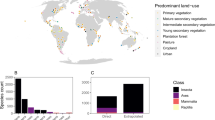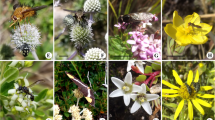Abstract
Despite the development of diversity indices in community ecology that incorporate both richness and evenness, pollination biologists commonly use only pollinator richness to estimate generalization. Similarly, while pollination biologists have stressed the utility of pollinator importance, incorporating both pollinator abundance and effectiveness, importance values have not been included in estimates of generalization in pollination systems. In this study, we estimated pollinator generalization for 17 plant species using Simpson’s diversity index, which includes richness and evenness. We compared these estimates with estimates based on only pollinator richness, and compared diversity estimates calculated using importance data with those using only visitation data. We found that pollinator richness explains only 57–65% of the variation in diversity, and that, for most plant species, pollinator importance was determined primarily by differences in visitation rather than by differences in effectiveness. While simple richness may suffice for broad comparisons of pollinator generalization, measures that incorporate evenness will provide a much more accurate understanding of generalization. Although incorporating labor-intensive measurements of pollinator effectiveness are less necessary for broad surveys, effectiveness estimates will be important for detailed studies of some plant species. Unfortunately, at this point it is impossible to predict a priori which species these are.


Similar content being viewed by others
References
Aigner PA (2001) Optimality modeling and fitness trade-offs: when should plants become pollintor specialists? Oikos 95:177–184
Aigner PA (2005) The evolution of specialized floral phenotypes in a fine-grained pollination environment. In: Waser NM, Ollerton J (eds) Specialization and generalization in plant-pollinator interactions. University of Chicago Press, Chicago
Allen-Wardell G et al (1998) The potential consequences of pollinator declines on the conservation of biodiversity and stability of food crop yields. Conserv Biol 12:8–17
Armbruster WS, Keller S, Matsuki M, Clausen TP (1989) Pollination of Dalechampia magnoliifolia (Euphorbiaceae) by male euglossine bees. Am J Bot 76:1279–1285
Balvanera P, Kremen C, Martinez-Ramos M (2005) Applying community structure analysis to ecosystem function: examples from pollination and carbon storage. Ecol Appl 15:360–375
Barthell JF, Randall JM, Thorp RW, Wenner AM (2001) Promotion of seed set in yellow star-thistle by honey bees: evidence of an invasive mutualism. Ecol Appl 11:1870–1883
Bosch J, Retana J, Cerda X (1997) Flowering phenology, floral traits, and pollinator composition in a herbaceous Mediterranean plant community. Oecologia 109:583–591
Boyd EA (2004) Breeding system of Macromeria viridiflora (Boraginaceae) and geographic variation in pollinator assemblages. Am J Bot 91:1809
Burd M (1994) Bateman’s principle and plant reproduction—the role of pollen limitation in fruit and seed set. Bot Rev 60:83–139
DeBenedictis PA (1973) Correlations between certain diversity indexes. Am Nat 107:295–302
Feinsinger P (1978) Ecological interactions between plants and hummingbirds in a successional tropical community. Ecol Monogr 48:269–287
Feinsinger P, Beach JH, Linhart YB, Busby WH, Murray KG (1987) Disturbance, pollinator predictability, and pollination success among Costa Rican cloud forest plants. Ecology 68:1294–1305
Fenster CB, Dudash MR (2001) Spatiotemporal variation in the role of hummingbirds as pollinators of Silene virginica. Ecology 82:844
Fenster CB, Armbruster WS, Wilson P, Dudash MR, Thomson JD (2004) Pollination syndromes and floral specialization. Annu Rev Ecol Evol Syst 35:375–403
Fishbein M, Venable DL (1996) Diversity and temporal change in the effective pollinators of Asclepias tuberosa. Ecology 77:1061–1073
Gomez JM, Zamora R (1999) Generalization vs. specialization in the pollination system of Hormathophylla spinosa (Cruciferae). Ecology 80:796–805
Grant V, Grant KA (1965) Pollination in the Phlox family. Columbia University Press, New York
Havens K (1999) Pollination biology: implications for restoring rare plants. Ecol Restor 17:216–218
Herrera CM (1987) Components of pollinator “quality”: comparative analysis of a diverse insect assemblage. Oikos 50:79–90
Herrera CM (1989) Pollinator abundance, morphology, and flower visitation rate: analysis of the “quantity” component in a plant-pollinator system. Oecologia 80:241–248
Herrera CM (2005) Plant generalization on pollinators: species property or local phenomenon? Am J Bot 92:13–20
Inouye DW, Gill DE, Dudash MR, Fenster CB (1994) A model and lexicon for pollen fate. Am J Bot 81:1517–1530
Ivey CT, Martinez P, Wyatt R (2003) Variation in pollinator effectiveness in swamp milkweed, Asclepias incarnata (Apocynaceae). Am J Bot 90:214
Johnson SD, Steiner KE (2000) Generalization versus specialization plant pollination systems. Trends Ecol Evol 15:140–143
Kandori I (2002) Diverse visitors with various pollinator importance and temporal change in the important pollinators of Geranium thunbergii (Geraniaceae). Ecol Res 17:283–294
Kay KM, Schemske DW (2004) Geographic patterns in plant-pollinator mutualistic networks: comment. Ecology 85:875–878
Kearns C, Inouye D (1997) Pollinators, flowering plants, and conservation biology. BioScience 47:297–307
Kearns C, Inouye D, Waser N (1998) Endangered mutualisms: the conservation of plant-pollinator interactions. Annu Rev Ecol Evol Syst 29:83–112
Keys RN, Buchmann SL, Smith SE (1995) Pollination effectiveness and pollination efficiency of insects foraging Prosopis velutina in South-eastern Arizona. J Appl Ecol 32:519
Klein AM, Steffan-Dewenter I, Tscharntke T (2003) Pollination of Coffea canephora in relation to local and regional agroforestry management. J Appl Ecol 40:837–845
Krebs CJ (1989) Ecological methodology. Harper and Row, New York
Kremen C, Williams NM, Thorp RW (2002) Crop pollination from native bees at risk from agricultural intensification. Proc Natl Acad Sci USA 99:16812–16816
Larsen T, Williams NM, Kremen C (2005) Extincion order and altered community structure rapidly disrupt ecosystem functioning. Ecol Lett 8:538–547
Lindsey AH (1984) Reproductive biology of Apiaceae. I. Floral visitors to Thaspium and Zizia and their importance in pollination. Am J Bot 71:375–387
Magurran AE (1988) Ecological diversity and its measurement. Princeton University Press, Princeton
Mayfield MM, Waser NM, Price MV (2001) Exploring the ‘most effective pollinator principle’ with complex flowers: bumblebees and Ipomopsis aggregata. Ann Bot 88:591–596
Memmott J (1999) The structure of a plant-pollinator food web. Ecol Lett 2:276–280
Memmott J, Waser NM (2002) Integration of alien plants into a native flower-pollinator visitation web. Proc R Soc Lond B 269:2395–2399
Motten AF, Campbell DR, Alexander DE, Miller HL (1981) Pollination effectiveness of specialist and generalist visitors to a North Carolina population of Claytonia virginica. Ecology 62:1278–1287
Ollerton J, Cranmer L (2002) Latitudinal trends in plant-pollinator interactions: are tropical plants more specialised? Oikos 98:340
Olsen KM (1997) Pollination effectiveness and pollinator importance in a population of Heterotheca subaxillaris (Asteraceae). Oecologia 109:114–121
Parker IM (1997) Pollinator limitation of Cytisus scoparius (Scotch broom), an invasive exotic shrub. Ecology 78:1457–1470
Parrish JAD, Bazzaz FA (1979) Difference in pollination niche relationships in early and late successional plant-communities. Ecology 60:597–610
Pettersson MW (1991) Pollination by a guild of fluctuating moth populations: option for unspecialization in Silene vulgaris. J Ecol 79:591–604
Potts SG, Dafni A, Ne’eman G (2001) Pollination of a core flowering shrub species in Mediterranean phrygana: variation in pollinator diversity, abundance and effectiveness in response to fire. Oikos 92:71
Primack RB, Silander JA Jr (1975) Measuring the relative importance of different pollinators to plants. Nature 255:143–144
Ricketts TH (2004) Tropical forest fragments enhance pollinator activity in nearby coffee crops. Conserv Biol 18:1262
Schemske DW, Horvitz CC (1984) Variation among floral visitors in pollination ability: a precondition for mutualism specialization. Science 225:519–521
Schemske DW, Horvitz CC (1988) Plant animal interactions and fruit production in a neotropical herb—a path-analysis. Ecology 69:1128–1137
Simpson EH (1949) Measurement of diversity. Nature 163:688
Smith B, Wilson JB (1996) A consumer’s guide to evenness indices. Oikos 76:70
Spears EE Jr (1983) A direct measure of pollinator effectiveness. Oecologia 57:196–199
Stirling G, Wilsey B (2001) Empirical relationships between species richness, evenness, and proportional diversity. Am Nat 158:286–299
Strauss SY, Sahli H, Conner JK (2005) Toward a more trait-centered approach to diffuse (co)evolution. New Phytol 165:81–89
Tepedino VJ (1979) The importance of bees and other insect pollinators in maintaining floral species composition. Great Basin Nat Memoirs 3:139–150
Thompson JN, Pellmyr O (1992) Mutualism with pollinating seed parasites amid co-pollinators: constraints on specialization. Ecology 73:1780–1791
Vazquez DP, Aizen MA (2003) Null model analyses of specialization in plant-pollinator interactions. Ecology 84:2493–2501
Vazquez DP, Morris WF, Jordano P (2005) Interaction frequency as a surrogate for the total effect of animal mutualists on plants. Ecol Lett 9:1088–1094
Waser NM, Price MV (1983) Pollinator behavior and natural selection for flower colour in Delphinium nelsonii. Nature 302:422–424
Waser NM, Chittka L, Price MV, Williams NM, Ollerton J (1996) Generalization in pollination systems, and why it matters. Ecology 77:1043–1060
Young HJ (1988) Differential importance of beetle species pollinting Dieffenbachia longispatha (Araceae). Ecology 69:832–844
Acknowledgements
We thank S. Armbruster, C. Brassil, M. Duffy, S. Emery, C. Herrera, F. Knapczyk, A. Roles, D. Schemske, D. Vazquez, and P. Wilson for helpful comments on the manuscript. Funding was provided by a Lauff Scholarship, Sigma-Xi Grant-in-Aid, NSF DEB-9903880, and NSF DDIG DEB-0408055. This is KBS contribution no. 1214.
Author information
Authors and Affiliations
Corresponding author
Additional information
Communicated by Jacqui Shykoff
Rights and permissions
About this article
Cite this article
Sahli, H.F., Conner, J.K. Characterizing ecological generalization in plant-pollination systems. Oecologia 148, 365–372 (2006). https://doi.org/10.1007/s00442-006-0396-1
Received:
Accepted:
Published:
Issue Date:
DOI: https://doi.org/10.1007/s00442-006-0396-1




